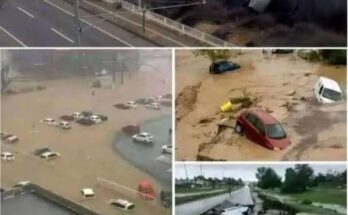DUBAI, United Arab Emirates (AP) — The rumble of explosions could be heard throughout Jerusalem on Friday, and Israeli TV stations showed plumes of smoke rising in Tel Aviv after an apparent missile strike.
There were no immediate reports of casualties. The army said dozens of missiles were launched, and the army has ordered residents across the country to move into bomb shelters.
Israel launched a wave of strikes across Iran that targeted its nuclear program and military sites, killing at least three top military officers and raising the prospect of an all-out war between the two bitter Middle East adversaries. It appeared to be the most significant attack Iran has faced since its 1980s war with Iraq.
The strikes came amid simmering tensions over Iran’s rapidly advancing nuclear program. For years, Israel had threatened such a strike and successive American administrations had sought to prevent it, fearing it would ignite a wider conflict across the Middle East and possibly be ineffective at destroying Iran’s dispersed and hardened nuclear program.
Israel launched blistering attacks on the heart of Iran’s nuclear and military structure earlier Friday, deploying warplanes and drones previously smuggled into the country to attack key facilities and kill top generals and scientists — a barrage it said was necessary before its adversary got any closer to building an atomic weapon.
The ongoing military and intelligence operation raised the potential for all-out war between the countries and propelled the region, already on edge, into even greater upheaval.
Iran quickly retaliated by sending a swarm of drones at Israel, and Supreme Leader Ayatollah Ali Khamenei warned of “severe punishment.” Iran had been censured by the U.N.’s atomic watchdog a day earlier for not complying with obligations meant to prevent it from developing a nuclear weapon.
Israel had long threatened such a strike, and successive American administrations had sought to prevent it, fearing it would ignite a wider conflict across the Middle East and possibly be ineffective at destroying Iran’s dispersed and hardened nuclear program.
But a confluence of developments triggered by Hamas’ Oct. 7, 2023, attack — plus the reelection of U.S. President Donald Trump — created the conditions that allowed Israel to finally follow through on its threats. Israeli Prime Minister Benjamin Netanyahu said the U.S. was informed in advance of the attack.
Countries in the region condemned Israel’s attack, while leaders around the globe called for immediate deescalation from both sides. The U.N. Security Council scheduled an emergency meeting for Friday afternoon at Iran’s request.
In a letter to the council, Iran’s Foreign Minister Abbas Araghchi called the killing of its officials and scientists “state terrorism” and affirmed his country’s right to self-defense. “Israel will come to deeply regret this reckless aggression and the grave strategic miscalculation it has made,” he said.
Israel’s military said about 200 aircraft were involved in the initial attack on about 100 targets. Its Mossad spy agency positioned explosive drones and precision weapons inside Iran ahead of time, and used them to target Iranian air defenses and missile launchers near Tehran, according to two security officials who spoke on condition of anonymity.
It was not possible to independently confirm the officials’ claims.
Among the key sites Israel attacked was Iran’s main nuclear enrichment facility in Natanz, where black smoke could be seen rising into the air. It also appeared to strike a second, smaller nuclear enrichment facility in Fordo, about 100 kilometers (60 miles) southest of Tehran, according to an Iranian news outlet close to the government that reported hearing explosions nearby.
Israel said it struck a nuclear research facility in Isfahan, too — though Iran didn’t immediately acknowledge it — and that it destroyed dozens of radar installations and surface-to-air missile launchers in western Iran.
Israel military spokesman Brig. Gen. Effie Defrin said the Natanz facility was “significantly damaged” and that the operation was “still in the beginning.”








